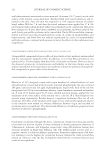NEXT-GENERATION NATURAL BABY BARRIER CREAM FORMULATIONS 175 these properties, it is a suitable candidate raw material that can be used to develop a w/o-type emulsion formulation. In terms of its physical properties, it is solid at room temperature (melting point about 64°C) and does not dissolve in water. Its composition consists of saturated fatty acid esters and long-chain alcohols (13,14). The conventional use of beeswax in cosmetic formulations is as a thickener and moisturizer. It is also cost- effective and available as a natural raw material all over the world (13,15). In recent years, natural, renewable, and biocompatible products are preferred for topical formula- tions, and beeswax is one of the most important candidates of these trend materials (16,17,18). OLIVE OIL Olive oil is a highly appreciated and promising vegetable oil because of its high soaping fraction in terms of pharmaceutical and cosmetic industry. Its composition includes oleic (65–80%), palmitic (7–20%), linoleic (4%), stearic (2–4%), and myristic acids (1%), and sometimes lauric and arachidonic acids (19). Also, vitamins and the presence of high concentrations of squalene, phytosterols, tocopherols, and linolenic acids give emollient and protective properties to olive oil for the epidermis. Furthermore, antioxidant proper- ties make it an important raw material for cosmetic formulations (20). BABY BARR IER CREAM FORMULATION PROPERTIES AND INGREDIENT SAFETY ASSESSMENT HYDROPHIL IC–LIPOPHILIC BALANCE (HLB) Emulsions consist of three components, which are the dispersing phase, dispersing me- dium, and emulsifi er. The emulsifi er is known as “surface-active agents” that carry both hydrophilic and hydrophobic groups on a long chain. The HLB system provides numeri- cal determination of the hydrophilic and hydrophobic character of surfactants to select a suitable emulsifi er mixture following the type of emulsion to be prepared (21). Surfac- tants result in emulsion formation by abruptly decreasing the surface tension between the two liquids forming the phases of the emulsion. It is possible to calculate the HLB value experimentally as described by William Griffi n in 1949 or theoretically using correct equations (22,23). PARTICLE/ DROPLET SIZE AND ZETA POTENTIAL OF FORMULATIONS There are electrostatic pushing forces and Van der Waals pulling forces that affect the stability of colloidal systems. Electrostatic propulsion forces are directly related to zeta potential and are used to assess the physical stability of the colloidal system. It is gener- ally desired to have ±30–50 mV in emulsions. Zeta potential measurement is based on measuring the velocity of particles applied to the electric fi eld using the Doppler princi- ple. If all the particles have high negative or positive zeta potential, they repel each other, and the dispersion is durable. The high zeta potential of the emulsions resulted in
JOURNAL OF COSMETIC SCIENCE 176 aggregation formation generally decreasing. Using a measuring device, both size and zeta potential are measured and using the dynamic light scattering technique, the laser light from the edge of the sample cell is sampled. RHEOLOGY R heology i s one of the most important parameters in the formulation characterization stage. Rheological properties of cream formulation have signifi cant effects on physical stability and the sensation it creates during application by the consumer. Rheological properties of emulsion are defi ned by measuring their viscosity. Viscosity is briefl y the resistance of the emulsion to fl ow and is a key parameter to ensure stability and to achieve the desired fl ow. The viscosity of the emulsion varies in proportion to the viscosity of the outer phase. If the emulsion is non-Newtonian or viscoelastic, it changes relative to the viscosity of the outer phase and is evaluated momentarily with velocity. Lipophilic com- pounds with medium molecular weight, such as wax and long-chain fatty alcohols, affect the viscosity of the oil phase of the emulsion. Besides, thanks to extensive experiments, they help select a suitable viscosity enhancer, which also takes into account the cream spread and tactual feel. THE MoS Th e safety margin is one of the crucial factors in the toxicological evaluation of topical cosmetics and pharmaceutical products. The reason for this is to prevent undesired con- centrations from reaching the skin as a result of the absorption of substances in the for- mulation. Safety evaluation is remarkable in cases where skin structure and barrier properties, such as baby rash, are impaired. Therefore, the systemic exposure dose (SED) of each substance that makes up the BBC formulation should be evaluated. While calcu- lating the exposure dose to be considered, the absorption area, the degree of skin rash, and the frequency and duration of use of the formulation are important. If a compound has either high molecular weight and high hydrophilic or hydrophobic properties, it is thought to have low penetration into the skin (20,21). SC is an absorption preventive barrier for hydrophilic compounds and, when its integrity is broke down, there is an in- crease in absorption of hydrophilic compounds (22,23). EXPERIMENT AL MATERIAL V itamin E (Sigma Aldrich, Gillingham, Dorset, United Kingdom), Dehymuls PGPH (BASF, Ludwigshafen, Germany), beeswax (Kale Chemicals, Istanbul, Turkey), Article 83 V (Croda, East Yorkshire, United Kingdom), zinc oxide, paraffi n wax, magnesium sulfate, paraffi n oil, cetyl ester, sodium borate, Vaseline (Spermaceti), BHT (Doğa Pharmaceuticals, Istanbul, Turkey), D-panthenol (provitamin B5) (Parkoteks, Istanbul, Turkey), EDTA, glycerin, shea butter (Coral Chemistry, IL), calendula oil (New Directions, Fordingbridge,
Purchased for the exclusive use of nofirst nolast (unknown) From: SCC Media Library & Resource Center (library.scconline.org)

























































































































